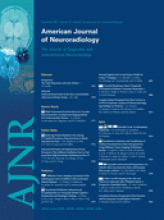Research ArticleBrain
Open Access
Brain Iron Quantification in Mild Traumatic Brain Injury: A Magnetic Field Correlation Study
E. Raz, J.H. Jensen, Y. Ge, J.S. Babb, L. Miles, J. Reaume, R.I. Grossman and M. Inglese
American Journal of Neuroradiology November 2011, 32 (10) 1851-1856; DOI: https://doi.org/10.3174/ajnr.A2637
E. Raz
J.H. Jensen
Y. Ge
J.S. Babb
L. Miles
J. Reaume
R.I. Grossman

References
- 1.↵
- Brown AW,
- Leibson CL,
- Malec JF,
- et al
- 2.↵
- Bazarian JJ,
- McClung J,
- Shah MN,
- et al
- 3.↵
- Ropper AH,
- Gorson KC
- 4.↵
- Thurman DJ,
- Alverson C,
- Dunn KA,
- et al
- 5.↵
- Hammoud DA,
- Wasserman BA
- 6.↵
- Medana IM,
- Esiri MM
- 7.↵
- Bakay L,
- Lee JC,
- Lee GC,
- et al
- 8.↵
- Jane JA,
- Steward O,
- Gennarelli TA
- 9.↵
- Adelson PD,
- Whalen MJ,
- Kochanek PM,
- et al
- 10.↵
- Povlishock JT
- 11.↵
- 12.↵
- 13.↵
- Jensen JH,
- Chandra R,
- Ramani A,
- et al
- 14.↵
- 15.↵
- Ge Y,
- Jensen JH,
- Lu H,
- et al
- 16.↵
- Kay T,
- Harrington D,
- Adams R,
- et al
- 17.↵
- Trenerry M,
- Crosson B,
- LeBoe J,
- et al
- 18.↵
- Delis DC,
- Kramer JH,
- Kaplan E,
- et al
- 19.↵
- Aubry M,
- Cantu R,
- Dvorak J,
- et al
- 20.↵
- Lull N,
- Noé E,
- Lull JJ,
- et al
- 21.↵
- Lifshitz J,
- Kelley BJ,
- Povlishock JT
- 22.↵
- Haber SN,
- Calzavara R
- 23.↵
- Shaw NA
- 24.↵
- 25.↵
- Connor JR,
- Menzies SL,
- Burdo JR,
- et al
- 26.↵
- 27.↵
- 28.↵
- 29.↵
- Bigler ED
- 30.↵
- Adelson PD,
- Jenkins LW,
- Hamilton RL,
- et al
- 31.↵
- 32.↵
- Craelius W,
- Migdal MW,
- Luessenhop CP,
- et al
In this issue
Advertisement
E. Raz, J.H. Jensen, Y. Ge, J.S. Babb, L. Miles, J. Reaume, R.I. Grossman, M. Inglese
Brain Iron Quantification in Mild Traumatic Brain Injury: A Magnetic Field Correlation Study
American Journal of Neuroradiology Nov 2011, 32 (10) 1851-1856; DOI: 10.3174/ajnr.A2637
0 Responses
Jump to section
Related Articles
- No related articles found.
Cited By...
- Individualised quantitative susceptibility mapping reveals abnormal hippocampal iron markers in acute mild traumatic brain injury
- Magnetic susceptibility of the hippocampal subfields and basal ganglia in acute mild traumatic brain injury
- Cortical iron-related markers are elevated in mild Traumatic Brain Injury: An individual-level quantitative susceptibility mapping study
- Distribution of paramagnetic and diamagnetic cortical substrates following mild Traumatic Brain Injury: A depth- and curvature-based quantitative susceptibility mapping study
- Altered oligodendroglia and astroglia in chronic traumatic encephalopathy
- Single Cell Molecular Alterations Reveal Pathogenesis and Targets of Concussive Brain Injury
- Brain iron overload following intracranial haemorrhage
- Classification algorithms using multiple MRI features in mild traumatic brain injury
This article has not yet been cited by articles in journals that are participating in Crossref Cited-by Linking.
More in this TOC Section
Similar Articles
Advertisement











